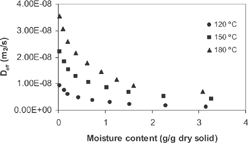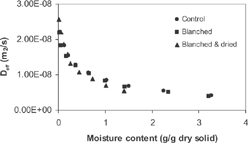Abstract
The effect of blanching and drying on water loss and oil uptake during potato slice frying was studied. Two pretreatments were carried out for the slices: (i) blanching in hot water at 85°C for 3.5 min; (ii) blanching in hot water at 85°C for 3.5 min and then, air-dried until a moisture content of 60 % (wet basis) was obtained. A control treatment, consisting of unblanched potato slices not air-dried was also conducted. After the pretreatments, potato slices were deep-fried in sunflower oil at 120, 150, and 180°C. With respect to the control treatment, blanching provided an increase while blanching-drying a decrease of the oil uptake. Two models, based on Fick's law, were used to describe water loss during frying. The first one is the classic model with an effective moisture diffusion coefficient, which assumed a constant value. The second model considers that the diffusion coefficient varies during the frying process. The variable diffusivity model adjusted the experimental data much better than the constant diffusivity model did. The effective moisture diffusion coefficient, in the variable diffusivity model, increased with frying time and temperature and behaved very similar for both control and blanched slices, while the increase of this coefficient was considerable higher for the blanched-dried slices. The development of a more porous structure with less oil content in the case of blanched-dried slices could explain this fact.
INTRODUCTION
Potato chips were invented in 1853 and quickly became very popular. Today they represent 33% of total sales of snack in US market.[Citation1] Retail sales in the US of potato chips are about $6 billion per year.[Citation2] Deep-fat frying is a widespread operation used throughout food processing industries as well in catering operations and home preparation of foods that creates unique textures and flavors in foods. Immersion frying has been defined as the immersion of a food product in an edible oil or fat heated above the boiling point of water,[Citation3] and may, therefore, be considered a dehydration process. Frying temperatures can range from 120–190°C, but the most common temperatures are 170–190°C. These conditions lead to high heat transfer rates, rapid cooking, browning, and texture and flavor development.[Citation4] Development of an oily and dry consistency is a major structural transformation occurring during frying of potato chips due to the high temperature and oil infiltration processes.[Citation5] High heat transfer rates during frying of potato induces major changes in the microstructure that, in turn, determines their final physical and sensorial attributes.[Citation6] The high heat transfer rates are due to the temperature differential between the oil and potato samples and a high convective heat transfer coefficient that is enhanced by the rapid escape of water, in the form of vapor, from the product.[Citation3]
In the potato chip process, raw potatoes are washed, peeled, sorted, and cut into slices. Some potato processing plants use blanching in hot water and drying with warm air to reach a moisture content of 60% (wet basis) prior to frying. Next, potato slices are usually fried in continuous fryers with hot oil (170-190°C), where they remain until the moisture level is less than 2% of the total weight. Finally, potato chips are salted, cooled in ambient air, and packaged. The blanching step improves the color and texture and could reduce the oil uptake by gelatinization of the surface starch.[Citation7] Air dehydration leads to a lower moisture content that also reduces oil absorption.[Citation8]
In recent years, several procedures have been proposed to reduce the amount of absorbed oil in fried potatoes. Fructose has been added to a restructured potato product that resulted in a change of the surface properties, with a reduction of absorbed oil after frying.[Citation9] Soaking of potato strips in NaCl solutions could reduce oil uptake in ∼15% in french fries after frying.[Citation10,Citation11] Predrying of potatoes is a common way to reduce fat uptake in the final fried product.[Citation12,Citation10] Vacuum frying may also be an option for fried potatoes with low oil content and the desired texture and flavor characteristics.[Citation1] Since the properties of the surface of the potatoes are most important for fat uptake, the application of a proper coating is a promising route to reduce oil content.[Citation13] Many options are available to reduce fat uptake by application of coatings or batters. For instance, gellam gum has been used to coat samples so that the resulting film reduced the oil uptake during frying.[Citation14]
In addition to the oil content reduction, knowing how pretreatments, such as blanching or drying, affect the water loss during frying is important. The water loss mechanism during frying is complex, and the transport by molecular diffusion, capillary, and pressure-driven flow should be determined.[Citation15] However, modeling at different levels of complexity has been reported. Moisture content of potato slices has been fitted with frying time and the square root of frying time.[Citation16] A more complex approach tested two models: one controlled by heat transfer and the other one by diffusivity of water in the tissue.[Citation17] A first order kinetic model has been considered in which the rate of moisture loss was proportional to the moisture content.[Citation18,Citation19] In more complex models, the crust and the core have been treated as two regions separated by a moving boundary and included a pressure-driven flow in the crust region.[Citation4] Liquid water transport has also been considered, resulting from convective flow and from capillary flow and vapor by convective flow and diffusion.[Citation15] With different approaches, the Fick's law of diffusion has been extensively used to describe the water loss kinetics during frying.[Citation20,Citation21] Fick's law of diffusion provides a simplified picture of the water loss during frying; however, in order not to oversimplify the transport process, it should be considered that using a variable effective diffusion coefficient would account for the change of physical properties of the material during frying.
The principal objective of this work was to i) compare the oil uptake during frying between control potato chips and those pretreated (blanched and blanched-dried); ii) apply Fick's law of diffusion, with constant and with variable effective diffusion coefficients, in order to model the water loss kinetics during frying at three temperatures for: (a) control potato slices, (b) blanched potato slices, and (c) blanched-dried potato slices.
MATERIALS AND METHODS
Materials
Potatoes (variety Panda, ∼20 % of dry solids) and sunflower oil (ChefTM, Coprona, Chile) were the raw materials. Potatoes that had been stored in a dark room at 8°C and 95% of relative humidity were washed and peeled. Slices (thickness of 2.5 mm) were then cut from the pith of the parenchymatous region of potato tubers using an electric slicing machine (Berkel, model EAS65). A circular cutting mold was used to provide chips with a diameter of 37 mm.
Pretreatments
Slices were rinsed immediately after cutting for 1 min in distilled water to eliminate some starch material adhering to the surface prior to frying. The following treatments were used: (i) Control or unblanched slices without predrying; (ii) Slices blanched in hot water at 85°C for 3.5 min; (iii) Slices blanched in hot water at 85°C for 3.5 min and then dried in a convection oven (Memmert, ULM 500, USA) at a dry bulb temperature of 60±1°C and an air velocity of 1±0.1 m/s until reaching a moisture content of 60±1 % (wet basis).
Frying conditions
Ten slices per sample time of each pretreatment were deep fried in 8 liters of hot oil contained in an electrical fryer (Beckers, Model F1-C, Italy) at each of the three temperatures tested: 120°C, 150°C and 180°C, with two replicates at each temperature. Potato-to-oil weight ratio was maintained as low as possible (∼0.0035) in order to keep the temperature of frying constant (±1°C). Slices were fried at different time intervals until a final moisture content of ∼1.8 % (wet basis) was reached. Previously, the corresponding minimum frying times to reach moisture content of ∼1.8% and the sampling intervals for each frying temperature were determined experimentally. For each selected sampling time, the fried slices were drained over a wire screen for 5 minutes and allowed to cool to room temperature before oil and water content analysis were done. The oil was preheated for 1 hr prior to frying, and discarded after 6 hr of use.[Citation22]
Analysis
Mean moisture content of potato chips was measured by drying the samples in a convection oven at 105°C until constant weight. The oil content was determined by a simple and rapid method that consists of an initial extraction with a mixture of 1:2:0.8 (v/v/v) in chloroform, methanol, and water. This mixture was then adjusted to 2:2:1.8 (v/v/v) to continue the oil extraction. In this way, the chloroform layer contained the purified oil.[Citation23]
Modeling Water Loss
Two models were used to describe water loss during frying. In the first, Fick's law of diffusion was used, which for one-dimensional transport is given by:[Citation24]
where l= half thickness of the slab (m); mt =moisture content (g water/g dry solid); m0= initial moisture content (g water/g dry solid); me= equilibrium moisture content (g water/g dry solid); t= frying time (s) and Deff effective moisture diffusion coefficient (m2/s). A constant value during the frying process was assumed. It is reasonable to assume that moisture content is negligible when equilibrium is reached in the frying process, so me= 0 in equation (1).[Citation14,Citation20,Citation25–27]
The second model considers that physical properties of the potato chip vary with changes in the temperature and moisture content during the frying process; in this way, the effective moisture diffusion coefficient is no longer a constant value but rather a function of time. Simplified methods, such as the method of slopes or numerical methods, have been used in order to obtain values of variable effective diffusivities from air drying curves.[Citation28] In this work, an extension of the analytical model of variable diffusivities proposed for spherical geometry to study air drying of grapes,[Citation29] and water loss during frying of potato strips[Citation10] was used. In the case of slab geometry, this model results in the following equation:
where Deff is postulated as a function of time as:
in which D0 is the effective diffusivity at time = 0, and b is a dimensionless parameter.
Since the diameter is considerable larger than the width in potato slices, it was assumed that the mass transfer takes place only in the axial direction (unidirectional).
The parameters of Eqs. (1) and (2) were obtained by non-linear regressions, using as objective function by the minimization of the relative deviations.
where Vobs is the observed or experimental value, Vpred is the predicted values, N the number of data points, and RMS is the root mean square error.
Statistical analysis
Analyses of variance were carried out when required using Statgraphic Statistical Package (Statistical Graphics Corporation, Version 4, Rockville, USA), which included multiple range tests (P>0.05) for separation of least square means.
RESULTS AND DISCUSSION
shows the final oil content for control and pretreated slices with final moisture content of ∼1.8 % (wet basis). For all the frying temperatures, the blanched-dried slices present the lowest oil content (P>0.05): for temperatures of 120 and 150°C, it was found that a decrease of around 20% with respect to control slices, while at 180°C the decrease was only 6%. On the other hand, oil content in blanched slices was always higher than control slices. Predrying decreases the initial moisture content of potato pieces and is an efficient way to reduce fat uptake in the final fried product.[Citation8,Citation10,Citation12] Contrary to expectation, blanched slices absorbed more oil than control slices; blanching has been reported as a pretreatment that could improve the color and texture of the chips and reduce their oil uptake.[Citation7] In agreement with our results, other research has found that blanching for high temperatures and short times (e.g. 97°C, 2 min) before frying of potato strips resulted in higher oil content than in control strips. Consumers find this result unacceptable in the product.[Citation30] The above blanching conditions are close to that used in this work (85°C for 3.5 min). On the other hand, some authors reported that low temperature blanching (e.g. 55-70°C) before frying activates pectinesterase enzyme (PME), and the resulting reactions decrease porosity and, hence, reduce oil uptake.[Citation31] Not only the frying temperature but also the pretreatment have a significant effect (P>0.05) on the final oil content of the potato chips.In the three pretreatments studied, the lower the frying temperature the higher the oil absorption.
Table 1 Final oil content in potato slices (g/g dried solid)Footnote*.
At the frying temperature of 180°C, the fit of moisture content with time data in Eqs. (1) and (2) are shown in for control slices. The variable diffusivity model adjusted the experimental data better than the constant diffusivity model did (%RMS < 10% as an average). and show the parameters obtained for both models. As can be seen, the values obtained for Deff are similar to those reported during frying of potato slices,[Citation20] discs of dough made from a biscuit mix,[Citation14] and potato strips;[Citation10] however, in all cases the RMSs for constant diffusity model were very high, indicating that this model is inadequate to represent the water loss of potato chips during frying. The effect on water loss in a thin and changing potato structure will be better represented by a diffusivity coefficient whose value also changes with time. Activation energies for constant diffusion coefficients calculated from data, shown in , were 4.5, 4.7, and 6 kJ/mol for control, blanched, and blanched and dried potato chips, respectively.
Table 2 Effective diffusivity coefficient and RMS values for constant diffusivity model.
Table 3 Parameters and RMS values for variable diffusivity model.
Experimental data and the fit to variable diffusivity model of water loss vs. frying time for control slices and blanched-dried slices are shown in A and B, respectively. Water loss increases with the frying temperature and time for both cases as expected. However, water loss is faster for each of the three frying temperatures in the case of blanched-dried slices (B). The variable diffusivity model fitted the experimental data properly since the average %RMS value for all the studied cases (3 frying temperatures and three pretreatments) was less than around 10% (). The value for D0 increased with the frying temperature for the 3 cases studied. It seems reasonable that the effect on water loss in a changing potato microstructure will be better represented by a diffusivity coefficient whose value changes with frying time. shows that, at a given temperature, Deff increases as the sample further loses moisture and also gains oil, probably because of the development of a more porous microstructure with frying time. The effect of the increase in temperature of water vapor during frying is higher than the resistant effect of the formed crust. As a result, Deff increases as drying progresses during frying. This fact suggests that the water leaves the potato tissue easily without a pronounced resistance of the external crust progressively formed that could eventually make Deff diminish with time, as was found earlier in potato strips fried at 180°C.[Citation10]
Figure 3 Observed and predicted water loss during the frying of (A) control slices; (B) blanched and dried slices. Circles, triangles, and squares represent experimental data for the frying temperatures of 120°C, 150°C, and 180°C, respectively. Solid lines represent the predicted values by the variable diffusivity model (Eq. (2)).
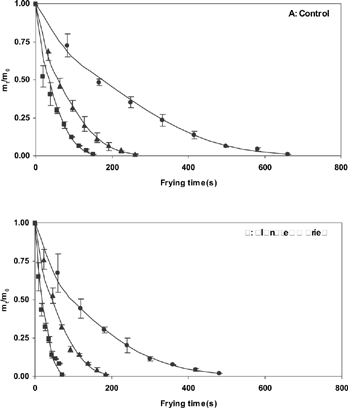
Figure 4 Effective moisture diffusivity during frying of control potato slices at 120°C, 150°C, and 180°C (Eq. (3)).
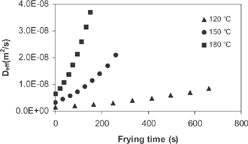
For the same frying temperature (e.g., 150°C), Deff behaves very similar in time for both control and blanched slices (). This fact was repeated also at 120°C and 180°C (results not shown). However, the increase in Deff with frying time at the same frying temperature (e.g., 150°C) for blanched-dried slices was considerably higher than for control and blanched slices. Blanched-dried potatoes have around 20% less oil. The effect of oil content on the moisture diffusion coefficient during air drying has been studied for some biomaterials such as avocado and oil-based model systems,[Citation33] and pepperoni.[Citation34] In all cases, it was found that the moisture diffusion decreases as the oil increases. This fact was attributed to the hydrophobic character of fat that imposes a resistance to the flow of water. However, during frying, most of the oil (70-80%) is absorbed at the end when the potato piece is removed from the fryer, so the flow resistance imposed by the oil to the flow of water during frying is negligible.[Citation35,Citation36,Citation37]
Figure 5 Effective moisture diffusivity during frying at 150°C of potato slices with different treatments (Eq. (3)).
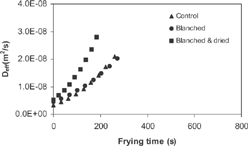
Deff increases as the potato slices dry during frying (). As the moisture content diminishes in potato slices, a more porous microstucture is formed. This makes the diffussion water easier. For the same moisture content, the higher the frying temperature the higher the D eff . When potato slices were fried at 150°C, Deff increases as the moisture content decreases during frying, independent of the pretreatment received by the potato slices (). The same trend was observed for the frying temperatures of 120°C and 180°C (results not shown). Deff depends principally on the moisture content of the potato slices during frying.
CONCLUSION
Blanched and dried potato slices absorbed less oil than control and blanched slices after frying. As the frying temperature increased, the potato slices absorbed less oil. The variable diffusivity model fit the experimental moisture data better than the constant diffusivity model. Effective moisture diffusivity increased with the frying time and temperature, and depended principally on the moisture content of the potato slices during frying. In the case of potato slices, the effect of an increase in temperature in the food during frying (which increases Deff) was more important than the increase in crust resistance (which decreases Deff).
ACKNOWLEDGMENTS
The authors acknowledge financial support from FONDECYT Project N° 1030411.
REFERENCES
- Garayo , J. and Moreira , R. 2002 . Vacuum frying of potato chips . J. Food Eng. , 55 : 181 – 191 .
- Clark , J.P. 2003 . Happy birthday, potato chip! And other snack developments . Food Technol. , 57 ( 5 ) : 89 – 92 .
- Hubbard , L.J. and Farkas , B.E. 1999 . A method for determining the convective heat transfer coefficient during immersion frying . J. Food Process Eng. , 22 : 201 – 214 .
- Farkas , B.E. , Singh , R.P. and Rumsey , T.R. 1996 . Modeling heat and mass transfer in immersion frying. Model development . J. Food Eng. , 29 : 211 – 226 . [CROSSREF]
- Pedreschi , F. , Aguilera , J.M. and Pyle , L. 2001 . Textural characterization and kinetics of potato strips during frying . J. Food Sci. , 66 : 314 – 318 .
- Pedreschi , F. and Aguilera , J.M. 2002 . Some changes in potato chips during frying observed by confocal laser scanning microscopy (CLSM) . Food Sci. Technol. Int. , 7 : 1 – 5 .
- Califano , A.N. and Calvelo , A. 1987 . Adjustment of surface concentration of reducing sugars before frying of potato strips . J. Food Processing Preserv. , 12 : 1 – 9 .
- Talburt , W.F. , Weaver , M.L. , Reeve , R.M. and Kueneman , R.W. 1987 . “ Frozen french fries and other frozen products ” . In Potato Processing , Edited by: Talburt , W.F. and Smith , O. New York : Van Nostrand Reinhold/AVI .
- Rubnov , M. and Saguy , I.S. 1997 . Fractal analysis and crust water diffusivity of a restructured potato product during deep-fat frying . J. Food Sci. , 62 : 135 – 137, 154 .
- Moyano , P and Berna , A.Z. 2002 . Modeling water loss during frying of potato strips: Effect of solute impregnation . Drying Technol. , 20 : 1303 – 1318 . [CROSSREF]
- Bunger , A. , Moyano , P. and Rioseco , V. 2003 . NaCl soaking treatment for improving the quality of french-fried potatoes . Food Res. Int. , 36 : 161 – 166 . [CROSSREF]
- Lamberg , I. , Hallstrom , B. and Olsson , H. 1990 . Fat uptake in a potato drying/frying process . Lebensm. Wiss.-u. Technol. , 23 : 295 – 300 .
- Mellema , M. 2003 . Mechanism and reduction of fat uptake in deep-fat fried foods . Trends in Food Sci. Technol. , 14 : 364 – 373 . [CROSSREF]
- Williams , R. and Mittal , G.S. 1999 . Low-fat fried foods with edible coatings: Modeling and simulation . J. Food Sci. , 64 : 317 – 322 .
- Ni , H. and Datta , A.K. 1999 . Moisture, oil and energy transport during deep-fat frying of food materials . Transactions of Ichem. Eng. Part C: Food and Bioproducts Processing , 77 : 194 – 204 . [CROSSREF]
- Gamble , M.H. , Rice , P. and Selman , J.D. 1987 . Relationships between oil uptake and moisture loss during frying of potato slices from c.v. record U.K. Tubers . Int. J. Food Sci. Technol. , 22 : 233 – 241 .
- Ashkenazi , N. , Mizrahi , S. and Berk , Z. 1984 . “ Heat and mass transfer in frying ” . In Engineering and Food,vol I,Engineering Sciences in the Food Industry , Edited by: McKenna , B. 109 – 116 . London : Elsevier Press .
- Gupta , P. , Shivhare , U.S. and Bawa , A. S. 2000 . Studies on frying kinetics and quality of french fries . Drying Technol. , 18 : 311 – 321 .
- Krokida , M.K. , Oreopolou , V. , Maroulis , Z.B. and Marinos-Kouris , D. 2001 . Deep fat frying of potato strips: Quality Issues . Drying Technol. , 19 : 879 – 935 . [CROSSREF]
- Williams , R. and Mittal , G.S. 1999 . Low-fat fried foods with edible coatings: Modeling and simulation . J. Food Sci. , 64 : 317 – 322 .
- Rice , P. and Gamble , M.H. 1989 . Technical note: Modeling moisture loss during potato slice frying . J. Food Sci. Technol. , 24 : 183 – 187 .
- Blumenthal , M.N. 1991 . A new look at the chemistry and physics of deep fat frying . Food Technol. , 45 ( 2 ) : 68 – 71, 94 .
- Bligh , E.G. and Dyer , W. 1959 . A rapid method of total lipid extraction and purification . Canadian J. Biochemistry Physiol. , 37 : 911 – 917 .
- Crank , J. 1975 . The Mathematics of Diffusion , 47 – 48 . Oxford : Clarendon Press .
- Kozempel , M.F. , Tomasula , P. M. and Craig , J.C. Jr. 1991 . Correlation of moisture and oil concentration in french fries . Lebensm. Wiss.-u. Technol. , 24 : 445 – 448 .
- Ateba , P. and Mittal , G.S. 1994 . Dynamics of crust formation and kinetics of quality changes during frying of meatballs . J. Food Sci. , 59 : 1275 – 1278, 1290 .
- Chen , Y. and Moreira , R. G. 1997 . Modelling of a batch deep-fat frying process for tortilla chips . Transaction of Ichem Eng. , 75 : 181 – 190 .
- Saravacos , G. D. and Maroulis , Z. B. 2001 . Transport Properties of Foods , 123 – 125 . New York : Marcel Dekker .
- Alvarez , I. and Legues , P. 1986 . A semi-theoretical model for the drying of Thompson seedless grapes . Drying Technol. , 4 : 1 – 17 .
- Alvarez , M.D. , Morillo , M.J. and Canet , W. 2000 . Characterization of the frying proccess of fresh and blanched potato strips using response surface methodology . Europ. Food Res. Technol. , 211 : 326 – 335 . [CROSSREF]
- Aguilar , C.N , Anzaldúa-Morales , R. , Talamás , R. and Gastélum , G. 1997 . Low-temperature blanch improves textural quality of french-fries . J. Food Sci. , 62 : 568 – 571 .
- Alzamora , S. M. and Chirife , J. 1980 . Some factors controlling the kinetics of moisture movement during avocado dehydration . J. Food Sci. , 45 : 1649 – 1651, 1657 .
- Palumbo , S. A. , Komanowsky , M. , Metzger , V. and Smith , J. L. 1977 . Kinetics of pepperoni drying . J. Food Sci. , 42 : 1029 – 1031 .
- Jason , A. C. 1965 . Effects of fat content on diffusion of water in fish muscle . J. Sci. Food Agric. , 16 : 281 – 284 .
- Bouchon , P. , Aguilera , J.M. and Pyle , D.L. 2003 . Structure oil-absorption relationships during deep-fat frying . J. Food Sci. , 68 : 2711 – 2716 .
- Aguilera , J.M. and Gloria-Hernandez , H. 2000 . Oil absorption during frying of frozen parfried potatoes . J. Food Sci. , 65 : 476 – 479 .
- Ufheil , G. and Escher , F. 1996 . Dynamics of oil uptake during deep-fat frying of potato slices . Lebensm. Wiss.-u. Technol. , 29 : 640 – 644 . [CROSSREF]


